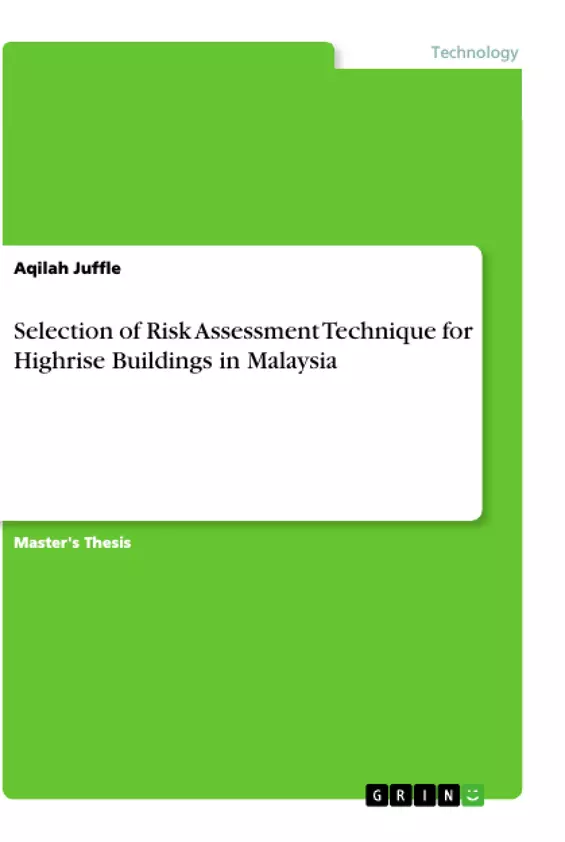This dissertation aims to develop structured guidance for the selection of RA techniques in the field of high-rise construction projects in Malaysia. In the first section of this research, an in-depth review of the literature regarding high-rise construction projects in Malaysia, risk management in construction projects, and risk assessment processes is presented. This is then analysed and validated using a questionnaire. The literature review covers what the factors need to take into account when selecting RA techniques, types of qualitative techniques and quantitative techniques, the manner on how such techniques were used, and finally, the advantages and disadvantages of qualitative and quantitative techniques. Following this, a quantitative questionnaire method is followed, whereby a survey is utilized in order to gain understandings and validate into their RA and risk performance assessment procedures.
The empirical analysis and findings of this research emphasis on the importance of RA for high-rise projects. Through the analysis and discussion, common types of RA techniques utilized, factors needed for selection of RA technique, and reasons to prefer RA techniques utilized by high-rise construction projects can be examined thoroughly. Overall, this research present an in-depth overview of RA, factors needed for selection of technique, and various qualitative and quantitative techniques utilized for high-rise construction projects.
Inhaltsverzeichnis (Table of Contents)
- Chapter 1 - Introduction
- Background
- Malaysian high-rise construction projects
- Statement of the research problem
- Research questions
- Research Aims and Objectives
- Research methodology
- Significance of the research
- Dissertation layout
- Chapter 2 - Literature review
- Risk management in construction project
- Risk assessment
- Tools and Technique for Risk Assessment
- Qualitative technique
- Quantitative technique
- Advantages and Disadvantages of Risk Assessment Technique
- Factors in the selection of Risk Assessment Technique
- Chapter 3 - Methodology
- Research approach
- Data collection
- Literature Review
- Questionnaire
- Questionnaire target sample
- Research questionnaire design
- Data analysis methodology
- Chapter 4 - Data Analysis
- Survey Response
- Presentation and Analysis of the Questionnaire
- Analysis of general respondents' background information
- Job responsibilities
- Respondents' Years of Experience
- Level of understanding of Risk Assessment experiences
- Respondent's Information and Performance in Construction Projects
- Stages at which risk assessment are utilized in construction project
- Risk Assessment process applied
- Techniques used by respondents
- Techniques implemented in the Construction companies
- Respondent's risk assessment analysis
- Factors influencing selection of RA techniques
- Qualitative Techniques usage frequencies
- Qualitative Techniques achieving comprehensive assessment of risk
- Quantitative Techniques usage frequencies
- Quantitative Techniques achieving comprehensive assessment of risk
- Availability of structured guidance for selection of risk assessment techniques
- Analysis of general respondents' background information
- SPSS Analysis
- One-way ANOVA test
- Reliability test
- Chapter 5 - Discussion
- Overall responses to the questionnaire
- Section 1
- Section 2
- Section 3
- Answering the research questions
- Overall responses to the questionnaire
Zielsetzung und Themenschwerpunkte (Objectives and Key Themes)
This dissertation investigates the selection of risk assessment (RA) techniques in high-rise construction projects in Malaysia. Its goal is to develop structured guidance for selecting appropriate RA methods in this context. Key themes explored in this research include:- The role of RA in high-rise construction projects in Malaysia
- Factors influencing the selection of RA techniques
- The advantages and disadvantages of different RA techniques (qualitative and quantitative)
- The application of RA techniques in practice
- The need for structured guidance on RA technique selection in the industry
Zusammenfassung der Kapitel (Chapter Summaries)
- Chapter 1: Introduction provides context for the research by discussing the background of high-rise construction in Malaysia, outlining the research problem, and presenting the research questions, aims, and objectives.
- Chapter 2: Literature Review examines existing literature on risk management, risk assessment, and RA techniques used in construction projects, particularly high-rise projects. It also analyzes the factors influencing the selection of RA techniques, the advantages and disadvantages of qualitative and quantitative techniques, and the application of these techniques in practice.
- Chapter 3: Methodology outlines the research approach, data collection methods (including literature review and questionnaire), and data analysis techniques employed in the study.
- Chapter 4: Data Analysis presents and analyzes the results of the questionnaire survey, covering respondents' background information, their RA practices, and the factors they consider when choosing RA techniques.
Schlüsselwörter (Keywords)
This research focuses on risk assessment, high-rise construction, construction project management, Malaysia, qualitative techniques, quantitative techniques, factor analysis, and structured guidance.- Quote paper
- Aqilah Juffle (Author), 2020, Selection of Risk Assessment Technique for Highrise Buildings in Malaysia, Munich, GRIN Verlag, https://www.grin.com/document/935431



